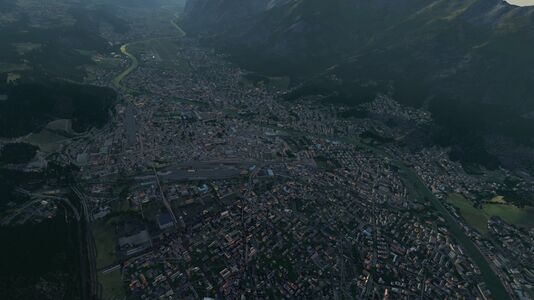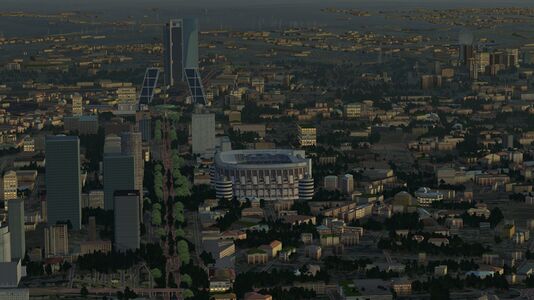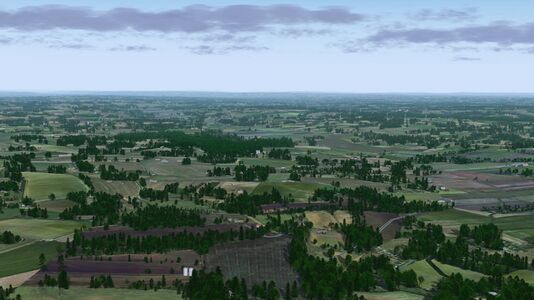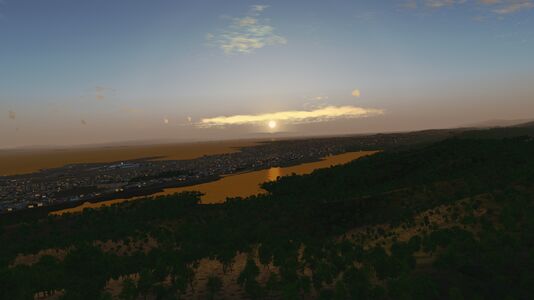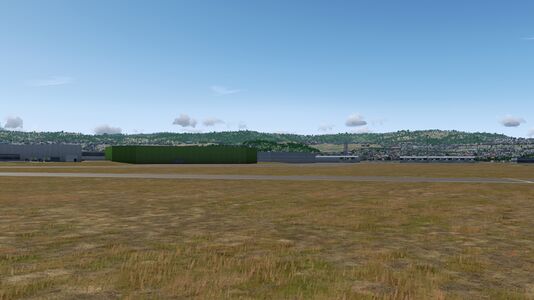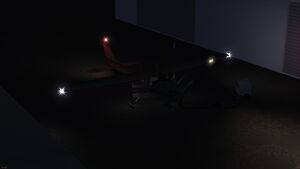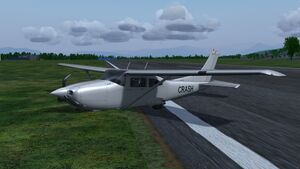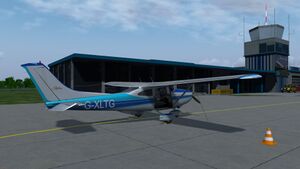FlightGear Newsletter April 2021
We would like to emphasize that the monthly newsletter cannot live without the contributions of FlightGear users and developers. Everyone with a wiki account (free to register) is welcome to contribute to the newsletter. If you know about any FlightGear related news or projects such as for example updated scenery or aircraft, please do feel invited to add such news to the newsletter.
Development news
| Note FG is currently undergoing a lot of huge changes. More importantly: moving to the OpenGL core profile, WS 3.0, osm2city buildings, photoscenery and Compositor shadows&lights.[1] It is likely the non-shader code path (fixed-function pipeline) will also go away in the next twelve months (~ early/mid 2022). We tried to communicate this: 2020.3 is the last release that will work on really old hardware: 'next' and future releases will need a more modern machine with an OpenGL 4 / DX12 class GPU.[2] 'next' is work-in-progress: likely 12 or 18 months before it becomes a release. In that time the minimum system requirements, performance baseline and basically everything else are going to change (and keep changing). Of course we'll try to make it work on as wide a range of hardware as possible, but right now we don't know, and it would be incorrect to speculate or promise anything. (Eg, we cannot say 'an Intel 4000 will work but an Intel 3000 won't - we have no idea!)
If next works for someone, that is great, but if you want stability, stable FPS and comaptability with older hardware, there is an easy answer: use 2020.3. That's what we recommend for everyone who wants to fly and enjoy flying. [3] |
2020.3.8 LTS released - OSM2City world-build release
FlightGear 2020.3.8 LTS has been released with an experimental 1st rollout of OSM2City buildings, roads and other objects for the entire world. Objects that are in the Open Street Map (OSM) database will be present. Automatic generation for areas without objects is disabled for this release.
See 1st World-build of OSM2City for information on what's included, and tips on performance/troubleshooting.
See 2020.3.8 LTS change log - included are improvements to Europe agriculture appearance, update to random scenery objects such as farm or industrial buildings and silos, California regional definitions improvements (now active), and updated water depth data (bathymetry).
- 2020.3.8 LTS improvements. Click to enlarge.
Release builds now include Appimages ![]() for Linux. See this discussion of hardware recommendations for modern FlightGear - although it is for 2018.3 LTS and doesn't cover the new experimental OSM2City (see the OSM2City page info for perfromance tips).
for Linux. See this discussion of hardware recommendations for modern FlightGear - although it is for 2018.3 LTS and doesn't cover the new experimental OSM2City (see the OSM2City page info for perfromance tips).
Homepage news posts on 2020.3 LTS
There is a draft page here for submissions of material for posts on the homepage about changes to FlightGear, Aircraft, Addons etc. since 2018.3 was released, with screenshots. The points are the important thing, don't worry if your English is not perfect. If you need suitable screenshots for the homepage (examples) for a specific craft or feature that aren't already available (1 , 2 , 3) in the wiki or forum, you can try asking in the forum media section.
The road ahead
See Help Wanted.
There are a lot of big projects that are currently under way - see the January newsletter for details for some of these projects. A lot of work (but not all) is already on the next branch (i.e. nightly builds). There is a lot to check out if you are curious - power users can run multiple installs of FlightGear in parallel. To contribute to any aspect of these projects, get in touch via the "fg-devel" mailing list.
Nightly builds with some of the big changes are available at download.flightgear.org as usual.
Please report bugs and issues via the sourceforge tickets system if you come across any on the next branch, or LTS.
Data Distribution Services Update: Property tree support
|
|
As of 04/2021, Erik has implemented an initial implementation of a property server using Data Distribution Service. And he has also taken the time to implement it like he once envisioned the remote property tree.
The idea is as follows:
You request a property path, the server responds with the property value and a property index.
Successive requests now can use the index to access the property removing the need to send the full property path every request saving both bandwidth and lookup time. After thinking about this a bit more I think future revision will have a different scheme.
1. Request the id of the property you are interested in.
2. You get an answer with the property value and id for that property.
3. From now on the server pushes an updated value for that particular
property id whenever the property value changes.
When set up properly DDS will keep the changed properties in it's cache for clients to read when they have time for it.
So no need to do successive requests anymore. Just wait and watch out for updates.
As an example, there is the fg_dds_prop utility in [GitLab]/flightgear/flightgear/next/src/Network/DDS/fg_dds_prop.cpp which can be used to either request a property path or a know property property ID.
And there is [GitLab]/flightgear/flightgear/next/src/Network/DDS/fg_dds_log.cpp which is able to log all DDS samples passing over the DDS network layer, including the new property sample format.
To access properties from a running version of FlightGear use the following command line parameter:
--dds-props=dds,out,<hz>
All this is 'next' only. [4]
World Scenery 3.0 update & FG 2021.x preview release plans
World Scenery 3.0 (WS3) is FlightGear's next generation scenery - see the January newsletter for more information. WS3 combines the benefits of different scenery approaches like WS2 and (raster) photoscenery without drawbacks, a bit like how the Compositor added shadows for certain cases and environmental lights that Rembrandt had without the performance drawbacks.
StuartB and ScottG have been making great progress.
- On the scenery generation technology side, the various different aspects are ready for a first iteration build - this will be at least as feature complete as WS2 - with landclass data, elevation data, roads coastlines/ beaches, water in fjords, rivers, inland waterbodies, being completed. StuartB's latest update improves coastlines, lochs and lakes and he has released a prototype scenery for Scotland with landclass data compiled by Scott: prototype download.
- On the rendering side there are a lot of projects that take advantage of the new scenery technology - there is a lot of ways for people to contribute to rendering through C++ or GPU (shader) programming. The rendering will build brick by brick - porting existing ALS features one by one, and then taking advantage of tech from WS3, new Compositor, and higher OpenGL to add new features one by one like transitions.
- On the scenery generation side there is an opportunity for people to help a world build - by cleaning and processing data - people who build sceneries currently should get in/keep contact on the mailinglist - see this post by Scott. People who have been creating landclass data by combining various sources should look to get their data into the WS3 world-build.
2021.x development preview release plans
The current thinking (early May) is to do a development preview release of FlightGear in the last half of 2021 with World Scenery 3.0 for at least part of the world - this release should fully switch to the Compositor. As always plans can change, and there are no fixed deadlines as progress depends on the availability of volunteers.
WS3 needs OSG 3.6 or 3.7. Windows nightly builds don't support OSG 3.6 or higher due to the OSG text issue, so WS3 is disabled for these as of April - but this may change in the near future. Currently people need to compile FlightGear with a higher version of OSG.
To contribute to any aspect of World Scenery 3.0 including testing, get in touch via the "fg-devel" mailing list.
New rendering pipeline for Compositor
Fernando has been experimenting with adding new rendering features, using the capabilities of the Compositor - see page for the new pipeline. The work is "*very* experimental", as Fernando said. It has not been released on the next branch as of writing this - although a very limited prototype is intended to be added to the FlightGear next branch. The new renderers will assume a higher version of OpenGL, which is one of the many big projects that are being worked on,
The Compositor is a framework to define rendering pipelines - so far the work has been to port the ALS renderer to the new framework, and add the distinguishing features of the old unmaintained Rembrandt renderer like shadows and environmental light definitions without being slow. The idea is to port existing features from both renderers to ensure everything works - the next preview release or LTS will transition to the Compositor. The next LTS will have the existing features as the classic rendering pipeline alongside any new pipelines that are finished, so there's no need to worry about performance hits of features from the new pipeline making very old hardware too slow to run FG. The new pipeline work builds on top. It investigates changing the physical model of aircraft surfaces (to something involving a version of PBR), adding lighting of surfaces from light bouncing off surrounding surfaces including real-time reflections, and implementing a new way of doing HDR algorithm using the new physically based surface model. Some tunable artistic glow (know as bloom) is also supported. The new pipeline is built on top of existing work, and will use the fast shadows and lights added to the ALS port. Fernando hasn't found a way to re-use occlusion data (finding what is visible in the view and what isn't, and culling invisible geometry) between passes in current Open Scene Graph (OSG), so he is using a deferred rendering approach in the prototype to overcome this OSG limitation - it means that anti-aliasing is restricted to post-processing that looks at the rendered image and tries to detect edges and blur them to remove jagged lines.
The current plan is to support GlTF ![]() (Graphics Language Transmission Format) as an alternative for 3d models in future - it supports the new surface model natively. This format also supports binary data (GLB file extension), and these will be smaller than AC files.
(Graphics Language Transmission Format) as an alternative for 3d models in future - it supports the new surface model natively. This format also supports binary data (GLB file extension), and these will be smaller than AC files.
As Fernando said, this is all very WiP and experimental - it's an investigation of various approaches like a lot of development. Plans can change. There is no timeline, and progress can vary based on availability of volunteers.
WiP screenshots - keep in mind this is very proof of concept using existing art not especially designed to take advantage of the new surface models, and it only works on aircraft carriers / over the sea. It's not an end-user demo of how a craft designed for these pipeline features will look when done, and shows features that people familiar with rendering and what's been tested can pick up on.
Related Software tools and projects
FGCom-mumble
FGCom-Mumble aims to provide a mumble based FGCom implementation. This will simulate radio communications in a seamless frequency spectrum. The project aims to be easy to use: Pilots just install the plugin, open mumble, join a channel on a mumble server and start using their radio stack in Flightgear.
The development is discussed in the FGCom-mumble topic on the forum ![]() . Releases can be downloaded from GitHub. The project also has a flightgear wikipage: FGCom-mumble
. Releases can be downloaded from GitHub. The project also has a flightgear wikipage: FGCom-mumble
Mumble 1.4.0 development master received plugin framework
The new plugin framework feature finally reached mumbles master development branch. This means that from now on, self-compiling users just need to build the ordinary master branch of the upcoming 1.4.0 or just use one of the precompiled Mumble 1.4.0 nightly development snapshots.
Plugin development status
Right now, the latest FGCom-mumble release v.0.12.0 fixes a bug with the new FGFS addon which prevented to load the protocol definition. If you tried the addon with 0.11.0, you need to patch your extracted addon folder manually with the provided upgrade.
Under the hood on the server side, the statuspage usage statistics got an upgrade that allows selection of the displayed timeframe of the graph. Also, stale clients have a grey icon now. Both is already available at the online statuspage of the test server.
Release 0.12.0 also brings support for MacOS users!
Also, we now have support for FlightGear ADF data, so the aircrafts first ADF receiver will pick up FGCom-mumble transmissions and drive the needle in your ADF gauge! This could for example be used to fly with user created NDBs (maybe radio stations) - just record something to a suitable frequency with the RadioGUI and enjoy your custom NDB navaid!
New nightlies and debug build release
On GitHub there are now also nightly builds that also provide a debug-version of the plugin, which will help in tracking down errors. The debug version provides extensive logging to the console, and optionally to a logfile if configured to do so. Please use such a debug log if opening tickets (if applicable), because it helps to track down what happened during execution.
In the hangar
New aircraft
BAE/Avro 146
The development of BAE146 starts 2 weeks ago. It's still unbublished. Main developer - SP-NTX.
To do:
- 3D Model.
- FDM (jsbsim).
- Cockpit.
- Screens (Canvas).
- Wiki page.
Updated aircraft
Cessna 182S / 182T
The Cessna 182S (git version) got some really exiting enhancements over the last half year, and is now also available on FGAddon:
- The EGT Indicator knob got a long due label now and features the original scale as well as a properly yellow colored needle.
- The CHT was retextured with the original scale too.
- The VOR gauges have the yellow tick marks as reference for the course wheel; and the OBS label on the knob.
- The ADF gauge features red ticks and a more detailed aircraft symbol.
- The transponder buttons are visually depressed when clicked now.
- The KAP-140 Autopilot was upgraded to Sascha Reißners new version and the control loop finetuned by Josh Davidson. This new version does not only feature a nice preflight check, but brought the realism to a whole new level. The UP/DN buttons can be used now to change altitude in ALT mode when continuously pressed, the AP disconnects in high-G situations and it features an AP disconnect knob as well as a CWS knob to temporarily disengage. The autopilot now realistically simulates the attached servo motors to drive the flight control surfaces, and they can of course fail. The REV mode now actually works and one can do a all-angle-intercept from ROL mode into NAV/APR/REV.
- The model supports damage now, so you can crash the gear when landing too hard and actually see that.
- Flying too low in forests make you hit the trees now.
- The pilot seat position can be adjusted forward/backward and this is stored.
- Starting the engine now causes visible vibrations in the plane.
- Spark plug icing is simulated, so in freezing conditions when the engine just revolves a few rounds and then quits, it possibly may not be able to start again.
- The radio stack was upgraded to the new model, supporting 8.33 channels.
- Multiplayer enhancements, many more properties are transmitted now. Also the custom registration was converted to canvas, making it visible in mutliplayer now (Note: When you use the new model, you will see the gear collapsed at old version multiplayer clients).
- Passengers and copilot are visually in the plane now (also in multiplayer!)
- Some corner cases in the FDM were fixed, most notably the plane is now more stable in high-wind conditions and also does not swing left/right so much when osciallating the yoke. Also the flap pitch reactions are even more realistic now.
- The gear damping values were revised and also the nose gear scissor animation was added as well as the oleo strut reworked.
- Some minor fixes and additions in the electrical system.
- Some minor fixes in the startup state system; also the GUI was reworked so it has a drop-down instead of a radio button menu.
- Aircraft tags were revised and switched to standard tags in some occasions.
- Splash screens where ported to the new system, and URLs were added so one can lookup documentation from the launcher.
- Aircraft menus were reordered and are more consistent to the C172p now. Also a small "about" dialog was added.
- Some small fixes in the failure manager, regarding failed flaps.
- The yoke can be shown/hidden with lowercase "y" now, previously it was just uppercase "Y", which is now in line with the C172. Also the yoke now goes transparent instead of being completely hidden (transparency level is configurable in the aircraft dialog).
- Some minor texture fixes in the cockpit.
- Dual control for a copilot to share the ride (view-only for now).
- Multiplayer Aerotowing support added.
- Adding support for the default "c" keybind to hide the 3D-cockpit.
- New f/F keybinds to adjust cowl flaps.
- Gravel- and Pavement roll sounds from the C172 project.
- Better all-angle.intercept handling for the KAP-140 autopilot (currently it sometimes briefly initiates a 45° turn when capturing the beam).
- Upgraded the Davtron M803 digital clock with new FT/ET alarm timers and ET count-down mode and fixed boot-up state.
- The starter motor power drain is more realistic now.
- The C182T is upgraded to include all shared systems to the current level of the C182S, so now the electrical system is working as intended and the failure manager can fail most systems specific to the T-variant too. The C182T can now also Ice and has the advanced fuel and engine system etc; also multiplayer fixes are contained.
- Update to use compositor lights
All those changed where deployed to the FGAddon hangar already!
Space Shuttle Milestone 13 released
Copy & Paste from this post by Thorsten: https://sourceforge.net/p/flightgear/mailman/message/37266972/ :
We're happy to announce the arrival of the Shuttle milestone 13 while at the same time welcoming GinGin as new collaborator in the team (who has done most of the work for this milestone). Given the state of the spacecraft before, you might reasonably ask - is there anything substantial that can still be added? You'll be the judge of that, but I think there is.
- thanks to new aero data, we now have a better description of the hypersonic flight phase from Mach 27 down to about Mach 5
- GinGin has been patiently digging into NASA documents and replaced my home-written guidance for the launch and entry trajectories by something that is much more shaped like the real thing, for instance the launch trajectory is now somewhat flatter and reaches a later arctop
- also, thanks to GinGin's patient work, we now have pretty much all the display pages very close to the original appearance (they've been moved to the original font, items blink where they should, and the limit sensing overlay which indicates when a value is off-nominal has been added)
- a lot of time has gone into testing and fixing issues with launch aborts. They're generally a wide field in that they probe a huge kinematical region in terms of what can happen, but are interesting because they actually showcase what the Shuttle can do with a rocket engine and as a hypersonic vehicle, and they provide a high-workload and challenging environment for the crew. We now have voice callouts for the abort boundaries (what maneuver should be flown when), as well as literally dozens of different cases tested and the guidance parameters adjusted to resolve small issues
- also, I've added the helium system (providing a purge for the engines during launch) including full failure and leakage capability, which was one of the last remaining systems that were not simulated in gory detail
- to make use of all that failure modeling, a new failure training mode throws a random scenario at selectable difficulty level at the user as a challenge - so you don't know up-front what will happen
- a new view to simulate the RMS arm camera simplifies grabbing objects in space
- a virtual notepad to record voice calls from mission control or display payload attachment points
All in all, with three people flying tests for more than a month, this is probably the best-tested milestone we ever had, and it's been verified to run all the way back to 2018.3. I'm currently in the last stages of updating the manual, which will be available within a few days [updated now].
Enjoy!
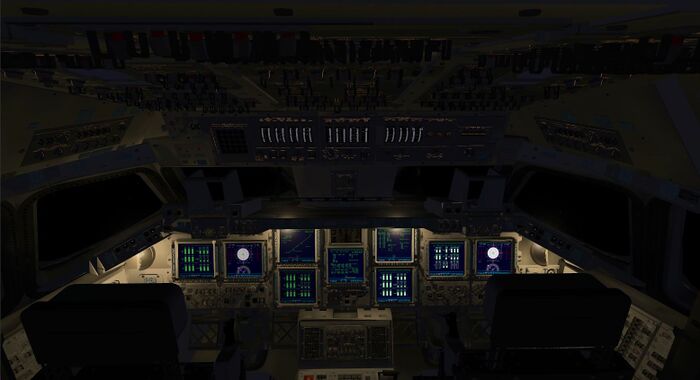
Instruments
- A fully simulated Davtron_M803 digital clock is now available, featuring all the timers and alarm modes. The source is currently in the c182s project. Forum thread: Davtron M803 topic on the forum

Scenery corner
Help wanted
Post LTS work
After the 2020.2 release, some work lies ahead to improve the LTS and to help us pave the way for migrating to the OpenGL Core profile - any help would be greatly appreciated.
This may for example include:
- Switching to the OpenGL Core profile:
- Checking that aircraft work with the LTS and documenting any major problems
- Include ffmpeg libraries in Windows and Mac builds, to enable built-in video encoding.
- Cppunit effort and FlightGear Headless (see Testing)
- Deboosting FlightGear
Please get in touch via the developers mailing list to learn more. See Post FlightGear 2020.2 LTS changes and 2022.X Release Plan for more details.
World Scenery 3.0
The FlightGear project is in the process of exploring how Virtual Planet Builder can be adopted. For details, see: World Scenery 3.0 roadmap
Aerial (drone) photos for Terrain textures
Wanted: good top-down aerial photos to create textures from to use with the procedural Regional Texturing system. Drones ![]() with cameras are ideal. People with access to drones are in a good position to take high-quality photographs.
with cameras are ideal. People with access to drones are in a good position to take high-quality photographs.
A particular need as of 2020 is photos of agriculture (farm lands) from different parts of the world.
Good GPLv2 compatible photos suitable for textures are hard to find, and an easy way is for people to take photos of their region. Flightgear's procedural systems can do a lot with less art content, so photo contributions can strongly improve visuals.
See: How to: take photos of terrain for textures. For examples of final textures: see /data/Textures/Terrain. e.g. UK countryside.
You can get in touch via the Scenery forum or the flightgear-devel mailing list
Photos of trees for textures
Wanted: good quality photos of different trees and vegetation from various parts of the world. Flightgear's vegetation system can handle multiple layers of trees and bushes.
Strong shadows should be avoided. Each tree should be against a background of a different colour: sky (preferably) , clouds , or buildings. This allows the tree to be separated from the background in a photo-editor like GIMP.
See: How to: take photos of vegetation. For examples of final textures: see /data/Textures/Trees. e.g. Coniferous.
You can get in touch via the Scenery forum or the flightgear-devel mailing list.
Submissions of labels for craft
Wanted: Submissions of labels (tags) giving a rough description of aircraft - Metadata tags. A quick read of a craft's Wikipedia page will normally be enough to set labels. This info will be searchable from the launcher GUI. For example, filtering craft by propulsion like single-propeller or 4-engine jet craft, or by a manufacturer like Airbus or Grumman, or by speed like supersonic craft, or craft by era like WW2. A list of tags is here - more can be added if needed. To add tags to craft yourself, the tags are stored in the set-xml file.
A list of FGAddon craft needing tags is here. See this forum thread to submit tags. The flightgear-devel mailing list or the craft's maintainer can also be contacted.
Windows Package Maintainer
The core team needs help from Windows users able to maintain a good working Windows build. This process already exists to support our Nightly and Release builds, but we are seeking additional help to keep it in good working order. The ability to compile FG from source and some Windows batch scripting is a required skill. If you are willing and able to take up this role, please reach out to James Turner (mailing list), or get in touch via the forum [5]
- ↑ https://sourceforge.net/p/flightgear/codetickets/2560/#76c9
- ↑ https://sourceforge.net/p/flightgear/codetickets/2560/#f6f6
- ↑ https://sourceforge.net/p/flightgear/codetickets/2560/#5802
- ↑ https://sourceforge.net/p/flightgear/mailman/message/37263034/
- ↑ https://forum.flightgear.org/viewtopic.php?f=42&t=37155
AI
The AI team makes FlightGear more realistic, colorful and lively every month. You can support the development of Interactive Traffic and contribute at the FlightGear AI subforum ![]() .
.
Community news
Wiki updates
- A new article was drafted, describing the "magical blue lever" aka. Constant speed propeller
FlightGear on Facebook
Since early December 2010, FlightGear has an official Facebook page. If you have a Facebook account please feel free to join the page.
FlightGear on Instagram
In January 2018 the @flightgear_sim Instagram account was brought back to life. If you've got nice screenshots to be featured, feel free to contact the maintainer ![]() .
.
FlightGear on FlightSim.com
FlightGear has also a sub-forum on flightsim.com - just like the commercial flight sims. It is an opportunity to showcase what FG can do, get people curious and answer any questions they may have with regard to the software or the project.
Multiplayer events
Upcoming events
A bunch of pilots currently do (mostly) GA flights on wednesdays evenings. Look at the forums for details! Everyone is welcome, the more, the merrier! We are casually flying, so no procedures/radio phrases knowledge needed (but we are happy if you do)
Contributing
Translators needed
| The FlightGear Wiki still needs help for translating it into various languages. If you are interested in making the FlightGear Wiki multilingual, you can start by looking at Help:Translate. | |
| Le wiki de FlightGear a toujours besoin d'aide pour être traduit en différentes langues. Si vous êtes intéressé par le rendre multilingue, commencez par lire Help:Traduire. | |
| Das FlightGear Wiki benötigt immer noch Hilfe bei der Übersetzung in verschiedene Sprachen. Wenn Du Interesse daran hast, das FlightGear Wiki mehrsprachig zu machen, dann fang mit dem Help:Übersetzen an. | |
| De FlightGear Wiki kan nog steed hulp gebruiken bij het vertalen van artikelen. Als je interesse hebt om de wiki meertalig te maken, raden we je aan om een kijkje te nemen bij Help:Vertalen. | |
| La wiki de FlightGear todavía necesita ayuda para traducirla a varios lenguajes. Si estás interesado en hacer la FlightGear wiki multilingüe, entonces comienza en Help:Traducir. | |
| La wiki de FlightGear encara necessita ajuda per traduir-la a diverses llengües. Si esteu interessat en fer la wiki de FlightGear multilingüe, llavors comenceu a Help:Traduir. | |
| A wiki de FlightGear ainda necessita de ajuda para traduzi-la em vários idiomas. Se estás interessado em tornar a wiki de FlightGear multi-lingual, por favor começa em Help:Traduzir. | |
| FlightGear 百科仍然需要志愿者将其翻译为各种语言。如果你有兴趣让FlightGear百科支持更多语言, 你可以查看 Help:Translate. |
FlightGear logos
If you want some graphic elements for your FlightGear-related site (such as a hangar or YouTube channel), please feel free to visit FlightGear logos for a repository of logos. And if you have some art skills, please don't hesitate to contribute with your own design creations.
Screenshots
The FlightGear project always needs screenshots, which show features that were added since the last release. These should be of good quality, especially in content and technical image properties. It is therefore recommended to use the best viable filter settings (anti-aliasing, texture sharpening, etc.). More info at Howto:Make nice screenshots.
Screenshot of the Month
If you want to participate in the screenshot contest, you can submit your candidate to the this subforum ![]() . Be sure to see the first post for participation rules. For purposes of convenience and organization, at the end of the month or after 20 entries have been submitted, a new forum topic will be started containing all shots in an easy-to-view layout. The voting will then take place there.
. Be sure to see the first post for participation rules. For purposes of convenience and organization, at the end of the month or after 20 entries have been submitted, a new forum topic will be started containing all shots in an easy-to-view layout. The voting will then take place there.
Thanks for reading FlightGear Newsletter April 2021!
| References
|

